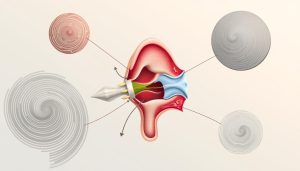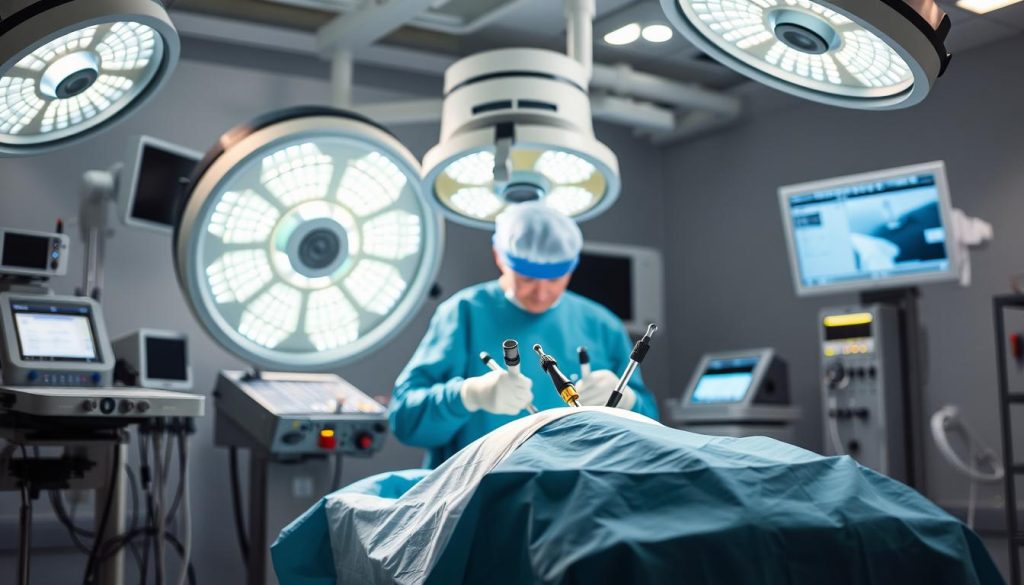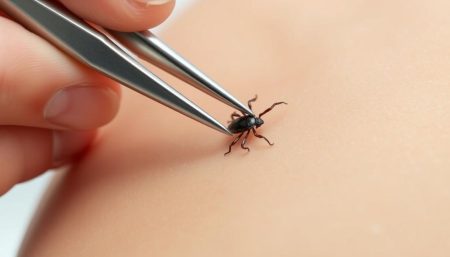Video-Assisted Thoracic Surgery (VATS) has revolutionized chest procedures. It’s a minimally invasive method that helps patients recover faster. VATS uses small incisions and special tools to treat chest issues.
VATS is a big step up from open chest surgery. Patients heal quicker and feel less pain. The small cuts also mean less scarring. This article will dive into how VATS works, its uses, and why it’s a top choice for many chest surgeries.
We’ll explore VATS’s history, how it’s performed, and the conditions it treats. We’ll also discuss how doctors prepare for VATS and what patients can expect after. By the end, you’ll understand this modern surgical method better.
Understanding Video-Assisted Thoracic Surgery (VATS)
Video-assisted thoracic surgery changed chest surgery for the better. It’s a way to treat many chest problems without big cuts. This method has changed thoracic surgery a lot.
The Evolution of VATS
Thoracoscopic surgery started in the early 1900s with simple tasks. The 1990s brought video technology, a big step up. Now, surgeons can do complex surgeries through tiny cuts, thanks to high-definition cameras.
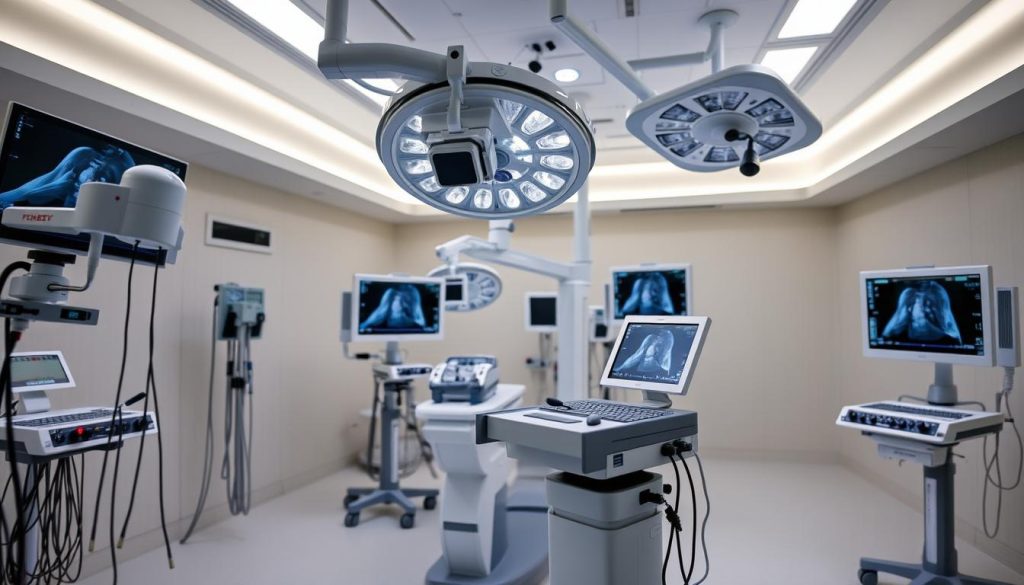
Core Principles and Tools
VATS uses special tools to get into the chest. A thoracoscope, a long tube with a camera, shows what’s happening. Surgeons use small ports to move instruments, doing precise work without hurting much tissue.
VATS vs. Traditional Surgery
VATS has many benefits over open surgery:
- Smaller cuts mean less pain
- Less blood lost during surgery
- Shorter hospital stays and faster recovery
- Lower chance of problems
- Looks better after healing
These points make VATS a good choice for many chest surgeries. As tech gets better, VATS can help more people, making them happier and healthier.
VATS in Surgery: Modern Applications and Techniques
VATS in surgery has changed thoracic procedures a lot. It brings new ways to do complex chest surgeries without big cuts. Surgeons use single-port and multi-port methods to treat more conditions.
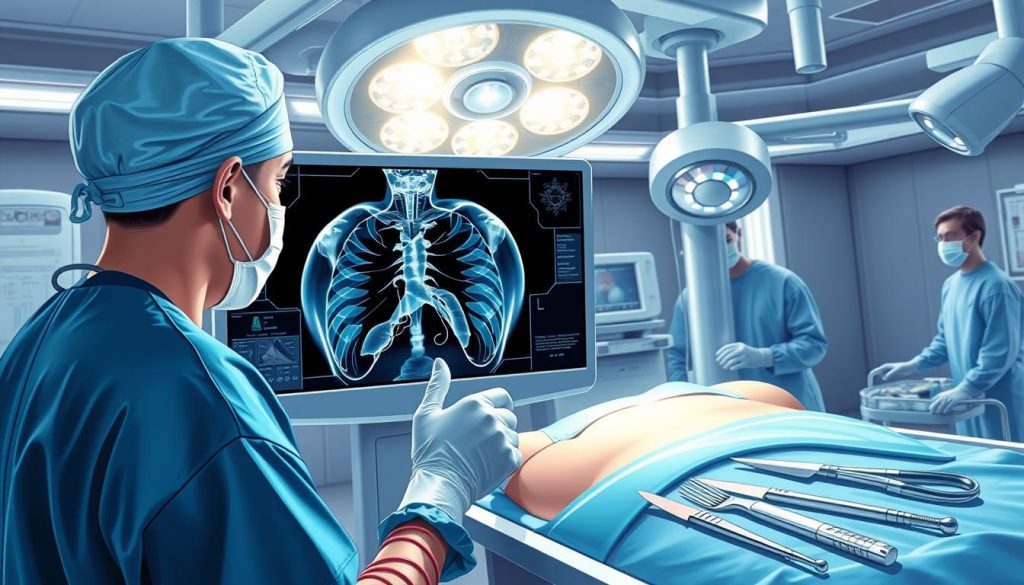
Now, lung surgeries that used to need big cuts are done with small ports. Surgeons can take out tumors, damaged parts, or even whole lobes with great accuracy. VATS also makes it easier to do biopsies in the chest, helping doctors find problems without hurting the chest too much.
VATS helps with pleural problems too. Doctors can handle fluid buildup, remove scar tissue, and do pleurodesis with less pain for the patient. Thanks to VATS, doctors can tackle more complex cases that used to need open surgery.
“VATS has transformed our approach to thoracic surgery, making recovery faster and outcomes better.”
New imaging and 3D systems help surgeons do VATS better. These tools let them see and work in complex areas with more confidence. This means they can treat more conditions than before.
- Lobectomies for lung cancer
- Thymectomies for myasthenia gravis
- Decortication for empyema
- Sympathectomy for hyperhidrosis
VATS is getting better, helping more people with less invasive surgery. As tools and methods keep getting better, thoracic surgery will keep getting better too.
Common Conditions Treated with VATS Procedures
VATS has changed chest surgeries for the better. It offers a way to do complex surgeries with small cuts. This means patients can heal faster and face fewer complications.
Lung Cancer and Tumor Resection
VATS is key in lung cancer treatment. Doctors use it to remove cancerous tissue through small cuts. This method is precise, saving healthy lung tissue.
Patients often feel less pain and heal quicker than with open surgeries.
Pleural Diseases Management
VATS is great for treating pleural diseases like pneumothorax and pleural effusions. It lets surgeons drain fluid, remove damaged tissue, and fix the pleural lining. This is a gentler way than open surgery, cutting down on hospital time and improving results.
Mediastinal Mass Removal
Surgeons use VATS to take out mediastinal masses and do lymph node biopsies. This method lets them check the chest cavity without big cuts. It’s less harsh on the body, leading to quicker healing and less pain after surgery.
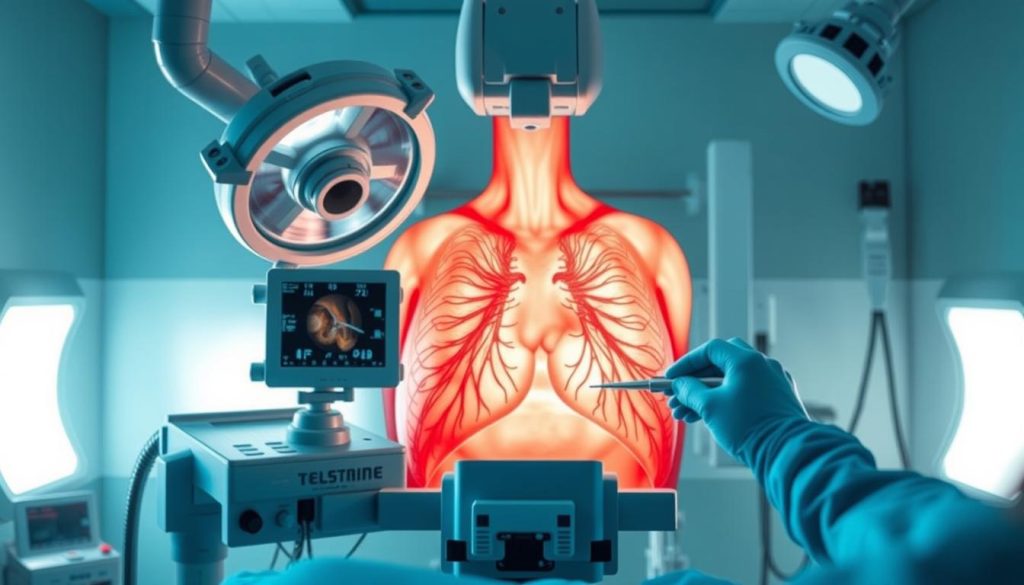
| Condition | VATS Procedure | Benefits |
|---|---|---|
| Lung Cancer | Lobectomy, Wedge Resection | Precise tumor removal, faster recovery |
| Pleural Diseases | Pleurodesis, Fluid Drainage | Less invasive, shorter hospital stay |
| Mediastinal Masses | Mass Excision, Lymph Node Biopsy | Reduced trauma, decreased post-op pain |
Preparation and Patient Selection Criteria
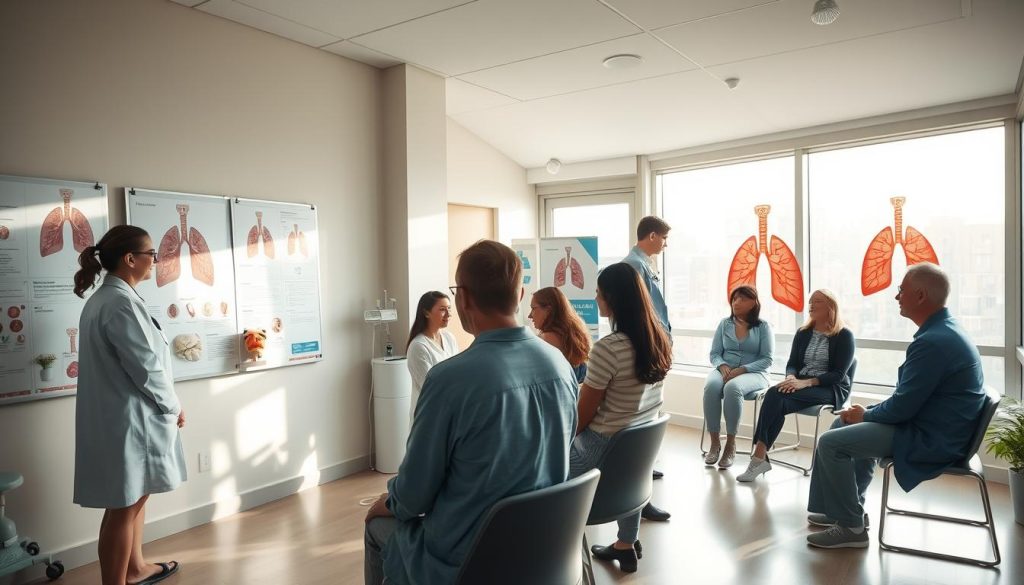
Choosing the right patients for Video-Assisted Thoracic Surgery (VATS) is key. Doctors use imaging and lung function tests to check if a patient is a good fit. These steps help figure out how far the disease has spread and the patient’s overall health.
What makes a patient a good candidate for VATS includes:
- Previous chest surgeries
- How much lung disease they have
- How well they’re doing overall
- If they can handle breathing with just one lung
Teaching patients about VATS before surgery is very important. Surgeons talk about what the surgery involves, the risks, and what results to expect. This helps patients understand their options better.
Patients having VATS usually don’t stay in the hospital as long as those with open surgery. VATS is less invasive, leading to less pain and quicker healing. This fits with the trend of using laparoscopic surgery more in medicine today.
“VATS has changed thoracic surgery, giving patients a less invasive choice with great results.”
By carefully picking patients and preparing them well before surgery, doctors can make VATS more successful. This leads to happier patients and better outcomes.
Technical Aspects of VATS Procedures
Video-assisted thoracic surgery (VATS) has changed endoscopic surgery a lot. It’s a minimally invasive method that needs careful planning and special tools. Let’s look at the main technical parts of VATS procedures.
Port Placement Strategies
Getting the port placement right is key for VATS success. Surgeons make 2-4 small cuts, each 1-2 cm long. They start with the camera port, then add working ports. The exact spot depends on the surgery and the patient’s body.
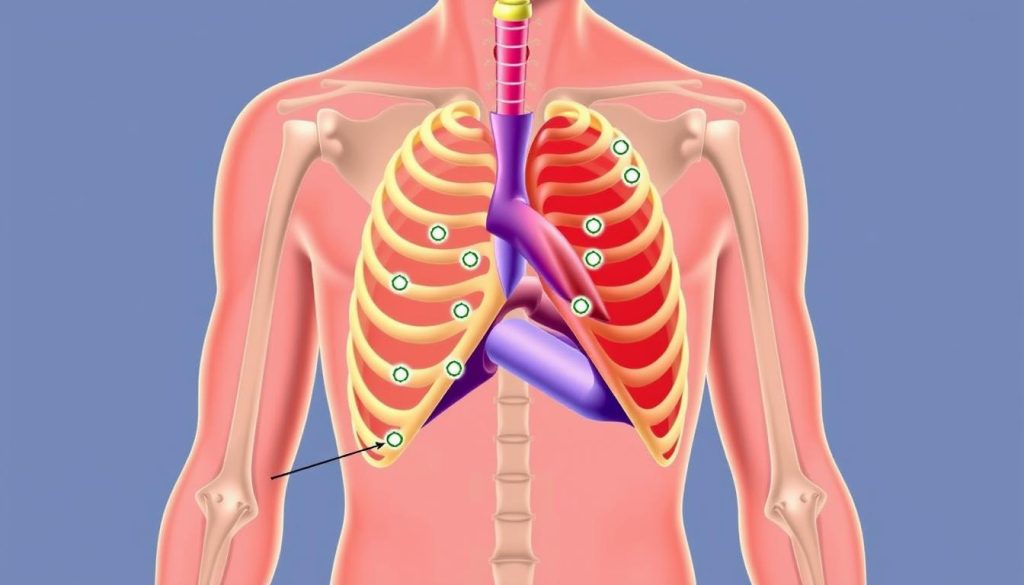
Surgical Navigation Systems
Advanced navigation systems make VATS more precise. They give real-time 3D images of the area being operated on. Surgeons can plan and track their tools with great accuracy.
This tech makes the surgery safer and cuts down on risks.
Equipment Requirements
VATS needs special tools. Key items include:
- High-definition thoracoscope
- Endoscopic staplers
- Energy devices for tissue sealing
- Long, curved instruments for thoracic access
| Equipment | Function | Importance |
|---|---|---|
| Thoracoscope | Visualization | Critical for surgical view |
| Endoscopic staplers | Tissue division and closure | Essential for resections |
| Energy devices | Hemostasis | Reduces blood loss |
| Specialized instruments | Tissue manipulation | Enables precise dissection |
These technical parts are the base of VATS surgery. Knowing how to place ports, use navigation systems, and handle special tools is vital. It ensures safe and effective minimally invasive thoracic surgeries.
Comparison with Traditional Open Surgery Methods
VATS in surgery has many advantages over traditional open surgery. This new method makes chest procedures better for patients. Let’s see how VATS stacks up against old ways.
VATS surgeries are quicker than open surgeries. Surgeons use small incisions to reach the chest. This means patients spend less time under anesthesia.
Blood loss is also lower with VATS. The small incisions and clear view help control bleeding. This means fewer blood transfusions are needed.
Patients feel less pain after VATS. The small cuts and less damage mean less discomfort. This leads to faster recovery and getting back to normal sooner.
Stays in the hospital are shorter for VATS patients. The procedure heals faster and has fewer complications. Patients often go home in days, not weeks like with open surgeries.
| Factor | VATS | Open Surgery |
|---|---|---|
| Incision Size | Small (1-3 cm) | Large (10-20 cm) |
| Pain Level | Low to Moderate | Moderate to High |
| Recovery Time | 2-4 weeks | 6-12 weeks |
| Scarring | Minimal | Significant |
Even with its benefits, open surgery might be better for some complex cases. The choice between VATS and traditional surgery depends on the patient’s needs and the surgeon’s skills.
Recovery and Post-Operative Care
After video-assisted thoracic surgery (VATS), patients start a vital recovery phase. This method, known as keyhole surgery, usually leads to quicker healing than open surgery.
Hospital Stay Duration
VATS patients often have shorter hospital stays. Most go home in 2-4 days, based on their procedure’s complexity. This shows how efficient these surgeries are.
Pain Management Protocols
Managing pain well is key for recovery. Doctors use several methods:
- Oral pain medications
- Local anesthetics
- Nerve blocks
Activity Restrictions
Even though VATS leads to quicker recovery, patients must follow some rules:
| Activity | Restriction Period |
|---|---|
| Lifting heavy objects | 4-6 weeks |
| Driving | 1-2 weeks |
| Return to work | 2-4 weeks |
Slowly increasing activity is important for a good recovery after surgery.
Potential Risks and Complications
VATS, like all surgeries, has risks. Thoracoscopic surgery has many benefits, but patients should know about possible complications. Air leaks, bleeding, and infection are common issues that can happen during or after VATS.
Air leaks happen when air gets out of the lung tissue. This can make a patient stay in the hospital longer and might need more treatment. Bleeding is less common in VATS than in open chest surgeries. Infection, though rare, can occur at the incision sites or in the chest cavity.
In some cases, surgeons might need to switch to an open procedure. This is done if complications come up or if unexpected challenges happen during the surgery. The rate of conversion depends on the procedure and the patient’s health.
| Complication | VATS Incidence | Open Surgery Incidence |
|---|---|---|
| Air Leak | 5-10% | 10-15% |
| Bleeding | 1-3% | 3-5% |
| Infection | 1-2% | 2-4% |
| Conversion to Open | 2-5% | N/A |
Surgeons work hard to reduce these risks. They use advanced tools to control bleeding and pick the right patients for VATS. It’s important for patients to talk about possible complications with their healthcare team before surgery.
Latest Technological Advancements in VATS
Video-assisted thoracic surgery (VATS) is changing fast with new tech. These updates make surgeries more precise and better for patients. Let’s look at the big changes in VATS.
3D Visualization Systems
3D systems have changed VATS for the better. Surgeons get better depth and space awareness. This means they can work more accurately and quickly.
Robotic Integration
Adding robots to VATS has raised the bar for small surgeries. Robots give surgeons more control and skill. They can do tricky tasks with ease.
Advanced Imaging Technologies
VATS now uses top-notch imaging. CT scans and fluorescence help during surgery. These tools make surgeries safer and more precise.
| Technology | Benefits | Impact on VATS |
|---|---|---|
| 3D Visualization | Enhanced depth perception | Improved surgical precision |
| Robotic Integration | Increased dexterity | Better control in complex procedures |
| Advanced Imaging | Real-time guidance | More accurate tumor removal |
These new techs are making VATS even better. They lead to better results, faster recovery, and more uses for VATS.
Cost-Effectiveness and Healthcare Economics
VATS in surgery has changed chest procedures, making them cheaper than old open surgeries. This new way of doing surgery has caught the eye of those who study healthcare costs and hospital managers.
Research shows VATS cuts hospital stays by 2-4 days compared to open chest surgeries. This means big savings in hospital costs and patient care. Plus, patients get back to work faster, saving on lost productivity.
Even though VATS equipment costs more at first, the long-term savings are worth it. Hospitals see fewer complications after surgery, which means fewer readmissions and less healthcare spending.
| Cost Factor | VATS | Open Surgery |
|---|---|---|
| Average Hospital Stay | 3-5 days | 7-10 days |
| Pain Medication Costs | Lower | Higher |
| Return to Work Time | 2-4 weeks | 6-8 weeks |
| Long-term Care Needs | Minimal | Often Required |
The move to VATS procedures has changed the economics of thoracic surgery. As more surgeons learn these techniques, VATS will likely get even cheaper. This will help both healthcare systems and patients.
Training Requirements for VATS Surgeons
To become skilled in video-assisted thoracoscopic surgery (VATS), surgeons need focused training. They must learn complex techniques and adapt to new surgery methods.
Learning Curve Considerations
The VATS learning curve is challenging. Surgeons must do many procedures to become experts. A training model for VATS helps shorten this process and improve skills.
Certification Programs
There are many certification programs for VATS surgeons. These programs check if surgeons follow high standards and know the latest techniques. To get certified, surgeons:
- Must do a certain number of VATS procedures
- Pass written and practical exams
- Show they are good at minimally invasive surgery
Ongoing Education
VATS surgeons must keep learning to stay updated. This includes:
| Educational Activity | Frequency | Benefits |
|---|---|---|
| Workshops | Quarterly | Practice new techniques hands-on |
| Conferences | Annually | Network and learn about new things |
| Simulation Training | Monthly | Practice complex procedures safely |
Following these training steps helps surgeons give top-notch care. This leads to better results for patients in VATS procedures.
Patient Outcomes and Success Rates
VATS procedures have changed thoracoscopic surgery for the better. They offer patients better results than traditional open surgeries. Studies show that VATS patients have less pain and shorter hospital stays.
Success rates for VATS depend on the procedure. For lung cancer surgeries, VATS matches open thoracotomy in long-term survival. A study of over 1,000 patients found a 5-year survival rate of 70% for early-stage lung cancer treated with VATS lobectomy.
| Outcome Measure | VATS | Open Surgery |
|---|---|---|
| Average Hospital Stay | 4-5 days | 7-10 days |
| Pain Score (0-10 scale) | 3-4 | 6-7 |
| Return to Work | 2-3 weeks | 6-8 weeks |
Outcomes for VATS depend on the surgeon’s experience and patient selection. High-volume thoracoscopic surgery centers usually get better results. Choosing the right patients, based on tumor size and location, is key for the best outcomes.
VATS improves quality of life, with patients recovering faster and breathing better. As surgery techniques and technology get better, VATS results will likely keep improving.
Integration with Other Minimally Invasive Techniques
VATS has changed chest surgeries, making them less invasive. With new technology, surgeons are mixing VATS with other methods. This mix improves patient results.
Hybrid Procedures
Hybrid procedures combine VATS with other methods. For example, VATS can be paired with mediastinoscopy for detailed lymph node checks. This combo helps stage lung cancer accurately and cuts down on surgery harm.
Combined Approach Strategies
Surgeons are coming up with new ways to mix VATS with endoscopic surgery. One method is using VATS with endobronchial ultrasound-guided biopsies. This method gives a clear view of the chest and allows for precise tissue samples.
These combined methods bring many benefits:
- More accurate diagnoses
- Less need for many surgeries
- Shorter recovery times
- Improved patient comfort
The mix of VATS with other minimally invasive surgeries is changing thoracic surgery. As technology gets better, we’ll see even more creative combinations. These will keep improving patient care and surgery results.
Future Developments and Trends
The field of thoracic surgery is changing fast, with VATS leading the charge. Researchers are looking into single-incision VATS and needlescopic surgery. These new methods aim to cut down on pain and speed up recovery times for patients.
Artificial intelligence and machine learning are set to change VATS procedures. These technologies will help with planning before surgery and making decisions during it. Soon, AI might help surgeons pick the best surgical plan based on patient data.
Robotic surgery is also growing in thoracic procedures. New robotic tech is making surgeries more precise and less invasive. Robotic systems with better 3D views and haptic feedback will give surgeons more control and skill.
As these technologies get better, we can look forward to:
- Smaller incisions and less damage to tissue
- Shorter hospital stays and faster recovery
- More precise and better surgical results
- Using VATS for more complex thoracic surgeries
The future of VATS surgery looks bright, with new tech on the horizon. These advancements will help both patients and healthcare workers. As these technologies spread, they will likely change thoracic surgery, making it safer, more efficient, and available to more people.
Insurance Coverage and Healthcare Policy
Understanding insurance for surgeries like VATS can be tricky. Many plans now cover minimally invasive surgeries, like laparoscopic ones. This is because these methods are seen as more effective and safer.
Coverage Requirements
To get VATS covered, you need to show it’s medically necessary. This means providing test results, records of past treatments, and a doctor’s note. Some insurers might choose VATS over open surgery because it’s faster and has less downtime.
Pre-authorization Process
Before VATS, you must get approval from your insurance. You’ll need to send in your medical history, treatment plans, and cost estimates. Your surgeon’s office will help with this, but it’s good to know what’s happening.
Cost Sharing Options
VATS can come with some costs you have to pay yourself. These include:
- Deductibles: What you pay before insurance starts
- Copayments: A set fee for certain services
- Coinsurance: A share of the total cost
| Cost Sharing Type | Typical Range | Notes |
|---|---|---|
| Deductible | $500 – $5,000 | Varies by plan type |
| Copayment | $20 – $100 | Per visit or service |
| Coinsurance | 10% – 30% | Of total procedure cost |
Healthcare policies are changing, making more surgeries like VATS covered. It’s important to talk to your doctor and insurance about what you’ll pay and what’s covered.
Choosing the Right Medical Center for VATS
Finding the right place for VATS surgery is very important. Look for hospitals with surgeons who do many VATS surgeries. These places have the latest technology and skilled teams, which helps with success.
Do your homework when choosing a hospital for VATS. Check if they are accredited and look at their success rates. It’s good if they offer care from the start to after the surgery. A team of experts is a sign of good care.
When you meet with doctors, ask about their VATS experience and success rates. Find out about their surgical methods and how they care for patients. Also, ask about possible problems and how they handle them. A trustworthy center will answer all your questions about VATS surgery.
FAQ
Q: What is VATS in surgery?
A: VATS stands for Video-Assisted Thoracic Surgery. It’s a way to do chest surgeries with small cuts. Special cameras and tools help surgeons work inside the chest.
Q: What are the advantages of VATS over traditional open surgery?
A: VATS is better because it heals faster and hurts less. You get smaller cuts and stay in the hospital less. It also looks better and causes less damage than open surgery.
Q: What conditions can be treated with VATS?
A: VATS helps with lung cancer and other chest problems. It’s used for lung removals and biopsies. It’s also good for other chest surgeries.
Q: How long is the typical hospital stay after a VATS procedure?
A: Hospital stays after VATS vary. But, they’re usually shorter than with open surgery. Many leave in just a few days.
Q: What are the possible risks and complications of VATS?
A: VATS is mostly safe, but there are risks. These include air leaks and bleeding. Rarely, it might need to turn into open surgery. But, these risks are lower than with open surgery.
Q: How is VATS different from robotic surgery?
A: VATS uses direct control with cameras and tools. Robotic surgery uses arms controlled by the surgeon. Some places use robots to help with VATS, combining benefits.
Q: What is the recovery process like after VATS?
A: Recovery from VATS is quicker than open surgery. You’ll feel less pain and can move around sooner. But, it depends on the surgery and your health.
Q: How experienced should a surgeon be to perform VATS?
A: Surgeons need special training for VATS. They should keep learning and have lots of experience. Ask about their VATS skills before surgery.
Q: Is VATS covered by insurance?
A: Most insurance covers VATS because it’s a proven method. But, it depends on your policy. Talk to your insurance and doctor about costs.
Q: What new technologies are being used in VATS procedures?
A: New tools for VATS include 3D systems and robotic help. There’s also advanced imaging like CT scans and fluorescence. These improve how precise and effective surgery is.











